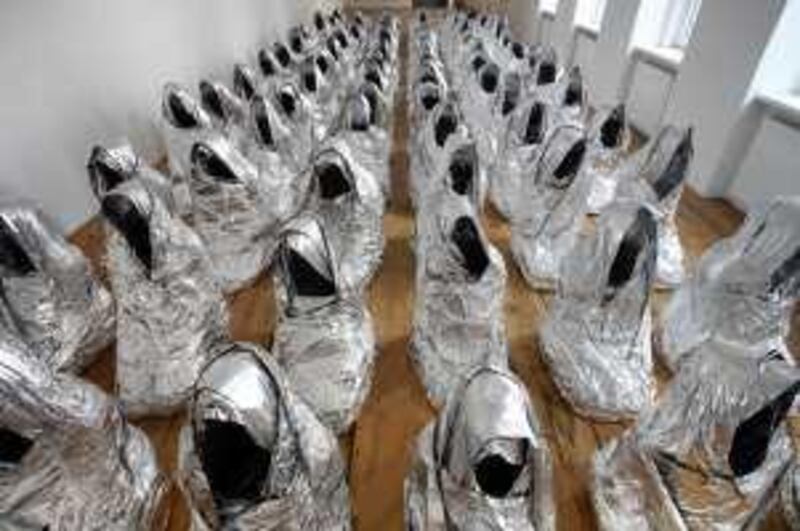Artists from the Middle East are increasingly rejecting the crude limits of curation by geography, Kaelen Wilson-Goldie writes. Zineb Sedira was born in Paris to Algerian parents and divides her time between London and Algiers. Oraib Toukan is a Palestinian with Jordanian citizenship who was born in Boston and lives in New York. Jananne al Ani was born in Kirkuk to an Iraqi father and an Irish mother and lives in London. Setareh Shahbazi was born in Iran, raised in Germany and recently relocated to Lebanon. These descriptions, detailing the bare-bones, biographical data of four contemporary artists, mean little on their own. They say nothing, for example, about how these very different artists work, what they create, in which context or why. But such descriptions have all been used to lump them together in the category of Middle Eastern art.
The rising interest in that category has a little to do with money and a lot to do with politics. Certainly, like any other financial market or economic sector, the art world has been adversely affected by the global recession. So the region - and more precisely the Gulf, with its wealth and future plans for new museums - looks like a more and more attractive area to be involved in, for those seeking everything from institutional partnerships and funding opportunities to the cultivation of emerging patrons and collectors.
But more to the point, the perception outside of the region that the Middle East is a vast (and geographically vague) source of violence and extremism has caused the art from this part world to be instrumentalised, used as a kind of conceptual counterweight to terrorism, the rise of Islamist ideology and an onslaught of jihadist threats. But 2009 might signify the year that such interest in Middle Eastern art blew up, burnt out and exhausted itself, yielding to a countertrend that is slowly but surely dismantling the need and even the usefulness of geography as an organising curatorial principle. Shows like Unveiled: New Art from the Middle East, at the Saatchi Gallery in London, and surveys in book form such as Contemporary Art in the Middle East, proved themselves more adept at packaging than investigating the subject they purported to examine. They came off more like advertising than art.
Exhibitions that carved different paths in the world or recontextualised regions as psychological terrains based on shared memory and historical experience - such as the Tate Triennial (which abandoned the idea of "Britishness" as its raison d'être) and the Istanbul Biennial (which followed the routes of modernisation and the legacies of socialism instead of tracing national borders) - managed to pry open and explore contemporary artistic practices in a much more meaningful way. Because they challenged viewers' assumptions, they lingered in ongoing conversations about the efficacy and purpose of contemporary art. As the year comes to a close, these are the shows that are still fresh in people's minds.
Of course, it is entirely likely that the attempts to wrap Middle Eastern art in a slick luxury sales catalogue or a crude political propaganda pamphlet will continue for some time to come. But the better and more accomplished artists from the region are already beginning to object (and decline) with the confidence that comes from having real alternatives. They have their own far more specific and complex concerns, and they have other platforms on which to explore them. Just as alternative approaches to exhibition making are taking hold, so too are alternative models to splashy international events, with initiatives including the Home Works Forum, the Meeting Points Festival, PhotoCairo or the Jerusalem Show becoming more vital than any cut-and-paste biennial.
What a joke it was, for example, for Zineb Sedira to sign on to the latest edition of the Alexandria Biennial, which opened two weeks ago, only to be "disinvited" at the last minute when "the Algerian pavilion" was cancelled due to the behaviour of sports fans, whom the organisers of the biennial "deemed indecent and going beyond the custom and practices of the Arab citizen who will always hold fast to the link forged between Arab blood and the Arab destiny".
"I would like to remind you that I am an artist," Sedira wrote in response to the organisers' decision. "I am devastated to be involved against my will in football rivalries between Egypt and Algeria - Our agreement pertained strictly to an artistic collaboration. It was solely within these terms that you had invited me ... I work constantly with artistic bodies over the world and remain, of course, open to any future proposals the biennale may make to me, in so far as, they remain purely within an artistic context."
The damage done here was not to the visibility of Sedira's work but to the status of the biennial, which resorted to the lamest of nationalist agendas and lost both interest and support by doing so. Marred by last-minute cancellations and numerous no-shows, the event was, in the end, a total flop. Kaelen Wilson-Goldie is a staff writer for The Review in Beirut.





